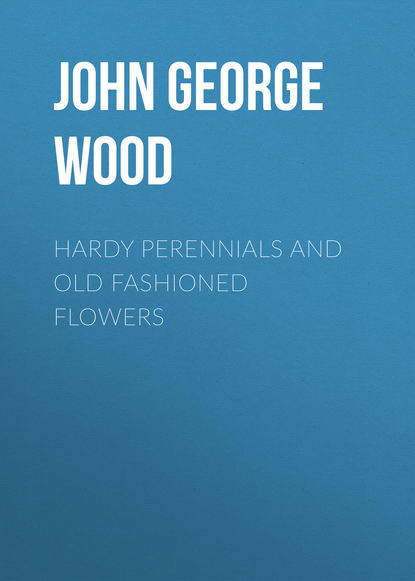 Полная версия
Полная версияHardy Perennials and Old Fashioned Flowers
Flowering period, March to May.
Saxifraga (Megasea) Cordifolia
Nat. Ord. SaxifragaceæA first-class herbaceous perennial, grown for over a hundred years in English gardens; it comes from Siberia, and consequently, it is very hardy in this climate. The Megasea section of the Saxifraga is a very distinct genus; there are several forms with but slight distinctions in the section, but the species now under notice may be readily distinguished from its nearest known relatives, first by its extra size in all its parts, next by its wrinkled heart-shaped leaves.
The flowers are produced on stout stems nearly a foot high, a section of which will cut the size of a sixpenny piece; the rose-coloured flowers are perfectly developed before they push through the many-times over-lapped foliage; they are neatly arranged, the branching stems sometimes giving the panicle of blossom the form and also the size of a moderate bunch of grapes. Just at this stage the flowers, to be most enjoyed, should be cut before the weather spoils their delicate colour. The fine pale green calyx, which is also conspicuous by its handsome form and extra length, is far from the least important feature of this flower, especially at the above-mentioned stage. The leaves are 6in. to 10in. across.
Of the use of its flowers in a cut state, a few words may be said. The weather soon destroys their beauty, but when cut they may be preserved for fully a fortnight. On one occasion I took a blossom and placed it in a flower stand for single specimen blooms; in this instance all the other glasses held such fine roses as Baroness Rothschild, Madame Lacharme, and Edouard Morren, but so richly did it compare with these roses that it was given the place of honour—the top centre glass; this flower I should say had never seen the full light in the open. After that others pushed out of the leaves and were speedily damaged, and not fit to cut.
Flowering period, March to May.
Saxifraga Coriophylla
Nat. Ord. SaxifragaceæThis is a rather recently discovered alpine species, very dwarf, but beautiful. The specific name would appear to be in allusion to its flowers as pink-shaped; they are very small, but the reader, by referring to the cut (Fig. 85), may form his own opinion of such likeness; however well founded or otherwise the name may be, we have in this subject a gem for the rock garden. It is a native of Albania, and belongs to that section of its extensive genus having triquetrous and obtuse leaves, or blunt three-sided foliage, as formed by a well developed keel. It is in flower in the middle of March, at the height of 2in. All its parts are of miniature dimensions, and yet when grown in a suitable position it is effective.
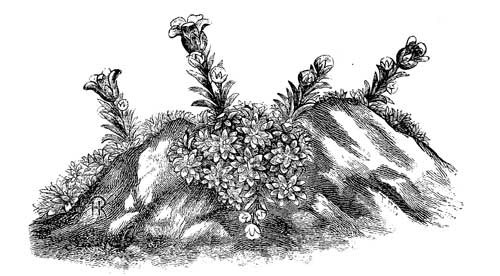
Fig. 85. Saxifraga Coriophylla.
(One-half natural size.)
The flowers are pure white, produced on leafy stems an inch or more high; they are few, and open in succession; petals round and overlapping; calyx large for the size of flower, and covered with down; sepals obtuse and tipped with a brown, almost red-tint; stamens short, having rather large yellow anthers, which fill the throat of the corolla. The leaves are evergreen or silvery grey, arranged in small rosettes, and ¼in. long, of good substance, rigid and smooth; their shape is obtuse, concave, and keeled; they are furnished with marginal excavations, which present themselves as dots; the habit is compact, the rosettes being crowded and forming cushioned-shaped specimens; the flowers last for a fortnight in average weather.
Between large stones in vegetable mould and grit, it both thrives and shows to advantage; it is also a charming subject for the pot culture of alpines. In company with the red-stalked and white-flowered S. Burseriana, the purple S. oppositifolia, and the many other forms of the mossy section, all, or nearly all in bloom about the same time, it offers a pleasing variety, as being distinct in every way from its contemporaries, more especially in the foliage. It is rather a slow grower, and not so readily increased as most Saxifrages; it is greatly benefited by having pebbles or small stones about the collar. These keep it moist at the roots during the growing season. If a little dry cow manure or guano is dusted amongst the stones during early summer, the results will soon be seen; such growth, however, should not be stimulated during the latter half of the year, or from its want of ripeness it will be liable to damage during winter. This practice of top dressing greatly assists the parts touching the earth to root, and so either an increased stock or larger specimens may sooner be obtained.
Flowering period, March.
Saxifraga Fortunei
Fortune's Saxifrage; Nat. Ord. SaxifragaceæThis, as may at once be seen by a glance at Fig. 86, belongs to the lobed-leafed section. It is as yet new in English gardens, and is often grown in pots in warm glasshouses. It is, however, perfectly hardy, having stood out with me in the open for the past three years. It is nearly related to S. japonica and its varieties, but is without the stolons or runners. In this climate, with outdoor treatment, it flowers in October until cut down by frost, which sometimes happens before the flowers get well out. It has been stated not only that it is not hardy, but that its flowering period is May. With me it has proved otherwise, and others have proved it to flower naturally in October. I also observed it in bloom in the Hull Botanic Gardens on the open rockwork in November, 1882. I have no doubt that autumn is the natural season for well-established plants to flower; weaker specimens may fail to push forth ere the frost cuts down their leaves, when the dormant buds must remain sealed for the winter, but ready to develope with the return of longer and warmer days.
The flowers are arranged in panicles on scapes nearly a foot high, the panicles being 6in. long and 3in. in diameter. The petals are long and narrow, of uneven length, and notched; colour pure white. The calyx is well developed; segments oval, notched at the ends; colour, pale apple green. Stamens, long and tipped with beautifully orange-coloured anthers. The ovary is prominent, and of a pale yellow. Besides the above features, the flowers, which mostly look sideways and are quite an inch across their broadest parts, have one very long petal at the low side, and the two next are at right angles with it, less than half its size, the two upper ones being still less; the effect is both unusual and pleasing. The leaf stalks are long, stout, and of a succulent nature, semi-transparent, and slightly furnished with longish hairs; the stipules are ample, and of a bright red, which colour extends for a short length up the stalk. The leaves are kidney-shaped, 2in. to 5in. across, eight or ten lobed, toothed and reflexed; they are furnished with solitary stiff hairs, are of good substance, and a very dark green colour, but herbaceous. The habit of this species is neat and very floriferous; therefore it is a valuable plant for in or outdoor gardening; but owing to its late season of flowering outside, the blossom is liable to injury. A bell glass, however, will meet the case; it should be placed over the plant, but tilted slightly, when there are signs of frost—the flowers will amply reward such care. If the bloom can be cut clean, a good cluster will vie with many orchids for delicacy and effect.
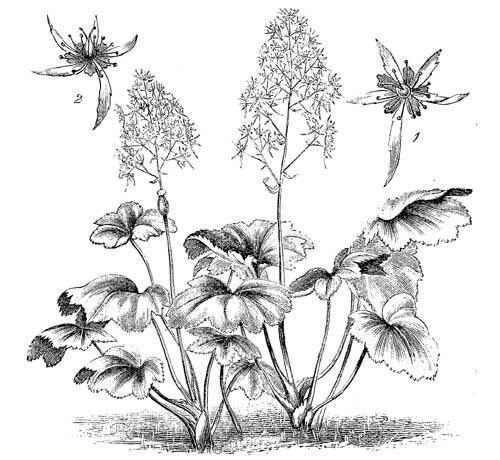
Fig. 86. Saxifraga Fortunei.
(One-fifth natural size; 1 and 2, full size.)
I find it to do well in fat loam, and with the same kind of soil in pots, which comes in for placing in cold frames when frost threatens. I find it one of the easiest plants possible to manage—in fact, it needs no care to grow it; still, many amateurs fail to keep it, I suppose from taking it into a warm greenhouse, where it is sure to dwindle. It is readily propagated by division of the crowns, which should be done in spring.
Flowering period, October until strong frosts.
Saxifraga (Megasea) Ligulata
Nat. Ord. SaxifragaceæOne of the large-leaved species (see Fig. 87) compared with others of the Megasea section, its leaves are strap-like, as implied by the specific name. It is sometimes called Megasea ciliata, but there is a large-leaved species, commonly called S. ciliata, which is very distinct from this one, and it is all the more important that they should not be confounded with each other, as S. ciliata is not very hardy, whilst this is perfectly so, being also one of our finest herbaceous perennials. It comes to us from Nepaul, and has not long been cultivated in this country.
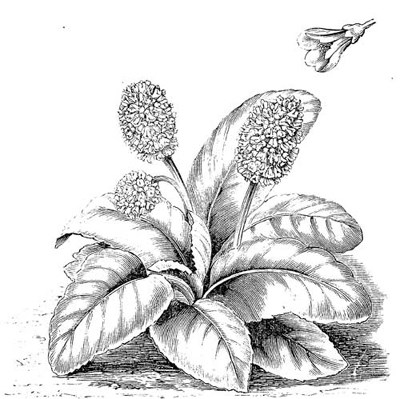
Fig. 87. Saxifraga (Megasea) Ligulata.
Its flowers are produced numerously on bold stout stems 10in. high. Sometimes the flower-stem is branched. The pale but clear rosy flowers are not only showy, but very enduring, lasting several weeks. The leaves are six to ten inches long, of irregular form, but handsomely ribbed and wavy; the new growths are bright yellowish-green, and tinted from the edges with a reddish bronze, so that, during spring, besides being finely in flower, it is otherwise a pleasing plant to look upon. Moreover, it is one of the few bold kinds of plants which flower so early and therefore a most valuable subject for the spring flower-beds.
It looks well in any position, either near or back from the walks, in shrubs, or as a centre specimen for beds; it is also a plant that may be moved easily, as it carries plenty of root and earth, consequently it may be used in such designs as necessitate frequent transplantings. It is not particular as to soil or position, but in light earth, well enriched with stable manure, I have found it to thrive, so as to be equal to many of the so-called "fine foliage" plants during summer; therefore, I should say, give it rich food. To propagate it, a strong specimen with branched crowns should be selected. These branches or stems are ½in. to 1in. thick. They should be cut off with as much length as possible; if they have a bit of root, all the better; if not, it does not much matter. Let the cut end dry for a little time, take off half, or even the whole, of the largest leaves, or the action of the wind will prevent their remaining firm. When so prepared, the cuttings may be deeply planted in sandy loam, which has previously been deeply stirred. This may be done as soon as the flowers are past, and by the end of the year the cuttings should be well rooted and suitable for moving into the ornamental part of the garden.
Flowering period, March to May.
Saxifraga Longifolia
Long-leaved Saxifrage; Queen of Saxifrages; Nat. Ord. SaxifragaceæNumerous and beautiful as are the species and varieties of this genus, this is the most admired of them all, from which fact it derives its proud name of "Queen." It is of recent introduction; habitat, the Pyrenees; but though of alpine origin, it thrives in lower, I may say the lowest, situations even in our wet climate. As will be seen by the illustration (Fig. 88), it belongs to the rosette section, and may indeed be said, for size and symmetry, to head the list. There are many forms of it, differing more or less in shape of leaves, colour, habit, and size of rosette. The original or reputed type is but an indifferent form compared with the one now generally accepted as the representative of the species. So readily do the various Saxifrages become crossed, that it is hard to distinguish them; and when a distinct form is evolved the question occurs, What constitutes or entitles it to specific honours? Surely the form of which we are speaking must be fully entitled to a name all its own, as it is not possible to find another Saxifrage that can so widely contrast with the whole genus.
It may be as well, in a few words, to refer to one or two varieties; and it shall only be from an amateur's point of view, whose estimate of their worth or importance is based entirely on their ornamental qualities under cultivation. Such varieties, as far as I know, have not had any name given them, descriptive or otherwise, and I for one have no desire to see any, as the genus is already overloaded with names.
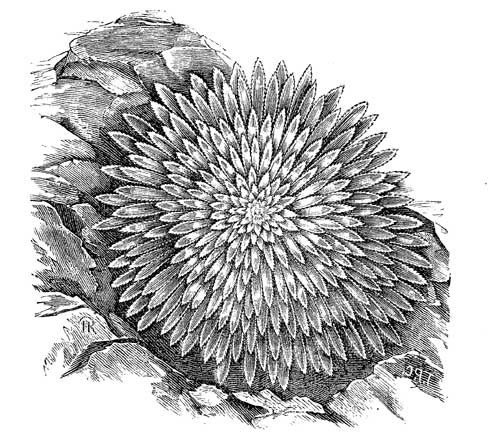
Fig. 88. Saxifraga Longifolia.
(One-fourth natural size.)
There is, first, a form whose main distinction is its dark olive-green leaves; the ends are rather inclined to be spathulate, they are long, narrow, and arch well, rather nearer the centre of the rosette; this causes the end of the outer circle of leaves to come flat on the ground. The whole specimen has a sombre appearance compared with the more silvery kinds. The second form has broader leaves, is more distinctly toothed and spotted; as a consequence of their width, the leaves are fewer, and though all the varieties are very formal, this is the most so. When by the side of what we may term the true form, which has sometimes vera added to its name, this one has a plain and somewhat "dumpy" appearance, and frequently the tips of the leaves curl back, which further detracts from its ornamental quality. A third form has small rosettes, pale green foliage, indistinct silvery dots, and, worse than all, the habit of throwing out a progeny of young growths all round the collar, furnishing itself as with a ruff, when the parent rosette turns to a yellowish-green. Of all the forms this is the most constant bloomer. The favourite variety, to which an engraving can do but scant justice, is superior to the above kinds in all its parts. Its blooming period is in early summer, but specimens often grow in size and beauty for three or five years without producing flowers. The foliage is the more admired feature, and is at its greatest beauty in December.
The flowers are borne in handsome panicles, in the style of those of S. pyramidalis, which are about 18in. high. The blossom is of the kind common to this section. The leaves are long, narrow, toothed bluntly, and spotted with silvery dots; the whole leaf is greyish; the habit is rigid and of even arrangement; the rosettes are of all sizes, from 2in. to 10in. in diameter. At 3in. to 6in. they are attractive, and as they grow larger, they become conspicuous in their beauty. It is not desirable to have them flower, inasmuch as the rosettes are then destroyed, though the plants do not die. Of course, if a specimen "shows bloom" it cannot be helped, but rather than lose a season's produce of young stock I would nip out the "lead," and so cause offsets to be produced instead of flowers.
In the rock garden this is one of the most telling subjects that can be introduced; not only does it love to have its roots amongst the stones, but it is a form which harmonises and yet contrasts finely with such shapeless material, and, further, relieves the sameness of verdure of other plants in a more than ordinary degree. It will grow in borders or beds, but looks nowhere so well as on rockwork. True, its uses are limited, but then they are exceedingly effective. I have grown this subject in almost every kind of soil and compost, and it has done well in most; stiff clay-like loam appears too cold or wet for it; on the other hand, a sandy loam, mixed with leaf soil, grows it finely; perfect drainage is the desideratum, in no matter what position it is planted. It may be increased in various ways—1st, By seeds, which may be bought, as it is carefully harvested abroad; 2nd, from offsets, as already stated; and, 3rd, from offsets produced by cutting out the leaves in two or more parts, so as to let the light in at the collar. This method may seem heartless, and it certainly spoils the specimen; it is a mode to be followed only where there are spare old plants and young stock is needed.
Flowering period, June and July.
Saxifraga Macnabiana
MacNab's Saxifraga; Nat. Ord. SaxifragaceæThis is a new and very beautiful variety, called after Mr. MacNab, who raised it in 1877. Of the several hundreds of species and varieties of this genus, it is doubtless one of the best and most distinct as regards its habit and rich flowers. So pronounced are its merit that, although I have not grown it for more than four years or so, I can have no hesitation in sounding its praise. It is possible that when it has become better established in the collections of amateurs and others, and when it has regained what may be termed its natural vigour, lost by the too rapid propagation common to new plants, it may prove to be even better than I have yet proved it. However that may be, there can at present be only one opinion respecting it.
The rosette foliage is in the style of S. longifolia and S. pyramidalis, intermediate; the flowers are quite distinct, but they remind one of the charming S. mutata, which is also a rosette form, having a fine panicle of blossom. It is said to be a seedling from S. Nepalensis crossed by S. cotyledon or S. pyramidalis, but, as the cross was accidental, there must be some uncertainty; both parents are evidently incrusted forms.
The flowers are ½in. across, corolla flat, petals richly spotted with numerous bright red spots; they are much shorter than the petals of most of the other incrusted varieties; they are also slightly reflexed in the more matured flowers; the calyx, too, is less hairy and the segments shorter than those of its reputed parents. The stem of my tallest specimen is not more than 15in. high; the panicle is large, beginning about four inches above the rosette. It is well branched, the flowers being clustered at the ends of the branchlets. The whole panicle will be about 10in. long and 6in. or 8in. through. As regards the foliage, I only need add to what has already been stated, that the leaves are arranged in somewhat lax rosettes, are strap, or tongue-shaped, evenly serrated, and, in the winter bright at the edges, with frosted or silvery markings; the flowers are so very attractive that casual observers readily recognise their beauties amongst hundreds of other Saxifrages, and they have not inaptly been compared with fine old china.
I ought not to omit mention of that rare quality possessed by this Saxifrage, viz., a rich perfume.
Though it is perfectly hardy, it may be grown in pots with great advantage, as then it can be the more closely examined; but if it is not convenient to grow it in that manner, it may be planted either on rockwork or in borders amongst choice things, where its flowers will not fail to command admiring notice. As to the kind of soil, it seems in no way particular. Sandy loam, mixed with peat, however, suits it well. It is propagated by offsets, but these are rarely produced in numbers, as is common with most of the incrusted Saxifrages. I may say that I have only met with one specimen which has thus proved useful in any degree worth notice, and it produced nearly a score of offsets during one season; it ripens much seed, which may, or may not come true.
Flowering period, June and July.
Saxifraga Mutata
Nat. Ord. SaxifragaceæA somewhat rare alpine species, evergreen, hardy, very distinct and beautiful. It is one of the rosette forms, after the style of S. pyramidalis, but there are several important variations about the plant, other than in the flowers, which are totally different. There are many peculiarities about this species, but they would hardly require to be noticed here were not the plant otherwise of great merit. When in bloom it is highly decorative, and the flowers in a cut state are unique.
The flower stem is 12in. to 18in. high, furnished with supplementary ones all its length; the lower ones are 8in. long, and spreading; they become shorter as they near the top, the whole forming a fine symmetrical panicle. The flowers are over ½in. across, petals awl-shaped, and, when first open, are nearly red; they change to dark orange and again to pale yellow; the calyx is very large, the sepals four times as broad as the petals and bluntly pointed; the stamens and anthers are coloured, and change like the petals; the ovary, which is very conspicuous, is a fine purple, but later, it, too, changes to a pink colour; the outer parts of the calyx and all the shorter flower-stalks, which are clustered at the ends of the supplementary stems, are greenish-yellow, and this feature of the plant adds much to its beauty. Calyx, stems, and stem-leaves are densely furnished with stiff gland-tipped hairs, rendering them clammy to the touch. The leaves of the rosettes are tongue-shaped, rough at the edges, fleshy, covered with glandular hairs, of a shining green colour, and slightly reflexed. The changeable nature of the flowers doubtless gives rise to the specific name. A well-flowered specimen is very effective on rockwork, but the panicles have a fault of heading over, from their weight, and also because, unlike S. longifolia and S. cotyledon, which have large and firm rosettes close to the ground to stay them, this species has a somewhat "leggy" rosette or a foot stalk, which is more or less furnished with browned and very persistent foliage. The flowers last a long time in good form, and, if grown clean, their yellow—nearly golden—stalks render them very useful in a cut state.
The propagation of this Saxifraga is more difficult than any other according to my experience, and I have heard of many who have found it the same. The offsets are not produced close to the ground, consequently have no rootlets; neither, from their hairy character, can they resist rot from moisture so well when planted as if they were bald, like the stolons of other species. I have found the best plan to be as follows: Take offsets before the plants flower; if there are none, which will often be the case, the bloom must be sacrificed by pinching out the stem. As soon as there are nice sized shoots ready, cut them off with all possible length of stalk; prepare a sandy patch of soil in a warm situation, lay them in a row on the surface, heads to the north, and then place a brick on them so as to hold all the cuttings in position; gently press on the brick, to cause the cuttings to assume a more natural position, and they will need no other attention until they become rooted; the brick will act as a screen from the hot sunshine, absorbing the heat to the benefit of the cuttings, as it will also absorb superfluous moisture. During the summer I have rooted many offsets in this way. That contact with the brick is favourable to the roots is evidenced by their clinging to it; no water should be given, however droughty the season may be—excessive moisture is the main thing to guard against.
Flowering period, June to August.
Saxifraga Oppositifolia (Lin.)
Purple Mountain Saxifrage, Purple Saxifrage, Blue Saxifrage, Opposite-leaved Saxifrage; Nat. Ord. SaxifragaceæDuring the month of March this is one of the most effective flowers in our gardens. The mossy appearance of its foliage, when dotted with its large blossoms, is hardly less beautiful than when the whole broad spreading tufts are literally packed with them. This must be a dear flower to all lovers of our native flora, for it not only comes very early, and in its wild homes on the Ingleborough, Welsh, and Scottish hills, greets and gladdens the rambler, who is, perhaps, making his first excursion of the year, but it is one of our most striking and beautiful flowers, even though they are produced on a plant of such humble size and habit. The pleasing and descriptive names of this gem of our hills would form a chapter in themselves. Even the old Latin names by which it was known, before the time when Linnæus arranged and re-named most of our native plants, bespeak a desire to do justice to a flower of more than ordinary beauty; and, as they were so strictly descriptive, at least one, I think, may be given without trying the reader's patience: Saxifraga alpina ericoides flore cæruleo, or the Blue-flowered Erica-like Mountain Saxifrage. Doubtless, shorter names are more convenient, but such specific names as the one just given are not entirely useless. Its present botanical name is in reference to the foliage only, but otherwise so distinct is this plant either in or out of bloom that no one could well mistake it.



